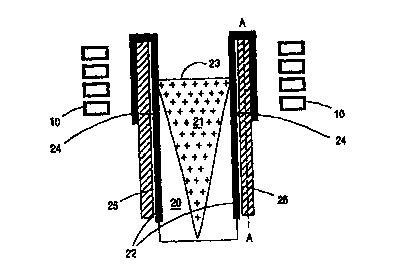Some of the information on this Web page has been provided by external sources. The Government of Canada is not responsible for the accuracy, reliability or currency of the information supplied by external sources. Users wishing to rely upon this information should consult directly with the source of the information. Content provided by external sources is not subject to official languages, privacy and accessibility requirements.
Any discrepancies in the text and image of the Claims and Abstract are due to differing posting times. Text of the Claims and Abstract are posted:
| (12) Patent Application: | (11) CA 2321723 |
|---|---|
| (54) English Title: | DEVICE FOR CASTING OF METAL |
| (54) French Title: | DISPOSITIF DE COULEE DE METAUX |
| Status: | Deemed Abandoned and Beyond the Period of Reinstatement - Pending Response to Notice of Disregarded Communication |
| (51) International Patent Classification (IPC): |
|
|---|---|
| (72) Inventors : |
|
| (73) Owners : |
|
| (71) Applicants : |
|
| (74) Agent: | ROBIC AGENCE PI S.E.C./ROBIC IP AGENCY LP |
| (74) Associate agent: | |
| (45) Issued: | |
| (86) PCT Filing Date: | 1999-03-03 |
| (87) Open to Public Inspection: | 1999-09-10 |
| Availability of licence: | N/A |
| Dedicated to the Public: | N/A |
| (25) Language of filing: | English |
| Patent Cooperation Treaty (PCT): | Yes |
|---|---|
| (86) PCT Filing Number: | PCT/SE1999/000313 |
| (87) International Publication Number: | WO 1999044769 |
| (85) National Entry: | 2000-08-22 |
| (30) Application Priority Data: | ||||||
|---|---|---|---|---|---|---|
|
A device for continuous or semi-continuous casting of metal comprising a
cooled mold (22) and an induction coil (10) arranged at the top end of the
mold. The mold comprises in its top end a plurality of hollow, old segments
(22a, 22b, 22c, 22d, 22e, 22f, 22'b, 22'c, 22'd) separated from each other by
partitions (26a, 26b, 26c, 26d, 26e), which all comprise an electrically
insulating barrier. Both the mold segments and the partitions are oriented
essentially in the casting direction. Each hollow top end mold segment
comprises a core of a mechanically supporting bar or beam (25a, 25b, 25c, 25d,
25e, 25f, 25'a, 25'b, 25'c, 25'd, 25'e, 25'f) arranged within the hollow mold
segment such that it is surrounded by the hollow mold segment. The core
exhibits superior mechanical properties in relation to the mold.
On décrit un dispositif de coulée continue ou semi-continue de métaux, qui comprend un moule refroidi (22) et une bobine d'induction (10) disposée au sommet du moule. Le moule comprend, à son extrémité supérieure, une pluralité de segments du moule (22a, 22b, 22c, 22d, 22e, 22f, 22'b, 22'c, 22'd) séparés les uns des autres par des cloisons (26a, 26b, 26c, 26d, 26e) toutes munies d'une barrière isolante. Tant les segments du moule que les cloisons sont essentiellement orientés dans le sens de la coulée. Chaque segment du moule creux de l'extrémité supérieure comprend un coeur de barre ou de poutre de soutien mécanique (25a, 25b, 25c, 25d, 25e, 25f, 25'a, 25'b, 25'c, 25'd, 25'e, 25'f) disposé à l'intérieur du segment du moule creux et encadré par ce dernier. Le coeur présente des propriétés mécaniques supérieures en relation avec le moule.
Note: Claims are shown in the official language in which they were submitted.
Note: Descriptions are shown in the official language in which they were submitted.

2024-08-01:As part of the Next Generation Patents (NGP) transition, the Canadian Patents Database (CPD) now contains a more detailed Event History, which replicates the Event Log of our new back-office solution.
Please note that "Inactive:" events refers to events no longer in use in our new back-office solution.
For a clearer understanding of the status of the application/patent presented on this page, the site Disclaimer , as well as the definitions for Patent , Event History , Maintenance Fee and Payment History should be consulted.
| Description | Date |
|---|---|
| Inactive: IPC from MCD | 2006-03-12 |
| Inactive: IPC from MCD | 2006-03-12 |
| Application Not Reinstated by Deadline | 2004-03-03 |
| Time Limit for Reversal Expired | 2004-03-03 |
| Deemed Abandoned - Failure to Respond to Maintenance Fee Notice | 2003-03-03 |
| Letter Sent | 2001-03-19 |
| Inactive: Single transfer | 2001-02-21 |
| Inactive: Cover page published | 2000-11-28 |
| Inactive: First IPC assigned | 2000-11-22 |
| Inactive: Courtesy letter - Evidence | 2000-11-14 |
| Inactive: Notice - National entry - No RFE | 2000-11-08 |
| Application Received - PCT | 2000-11-03 |
| Application Published (Open to Public Inspection) | 1999-09-10 |
| Abandonment Date | Reason | Reinstatement Date |
|---|---|---|
| 2003-03-03 |
The last payment was received on 2001-12-21
Note : If the full payment has not been received on or before the date indicated, a further fee may be required which may be one of the following
Please refer to the CIPO Patent Fees web page to see all current fee amounts.
| Fee Type | Anniversary Year | Due Date | Paid Date |
|---|---|---|---|
| Basic national fee - standard | 2000-08-22 | ||
| MF (application, 2nd anniv.) - standard | 02 | 2001-03-05 | 2000-12-19 |
| Registration of a document | 2001-02-21 | ||
| MF (application, 3rd anniv.) - standard | 03 | 2002-03-04 | 2001-12-21 |
Note: Records showing the ownership history in alphabetical order.
| Current Owners on Record |
|---|
| ABB AB |
| Past Owners on Record |
|---|
| ANDERS LEHMAN |
| ERIK SVENSSON |
| JAN-ERIK ERIKSSON |
| TORD KROON |